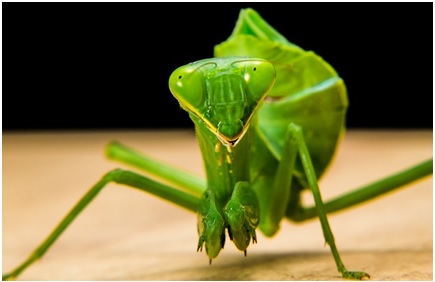Praying Mantis Could Help Build Better Robots
With their long bodies, bulging eyes and twig like limbs, praying mantises don’t exactly have the look of grace and agility, but looks can be deceiving.
The praying mantis is, in fact, a real aerial acrobat and, if there was an Animal Olympics, these odd-looking creatures would win the long jump, hands down. They’re able to make precision leaps and perfect landings faster than the blink of an eye, and have their own unique style too.
Aerial Acrobatics
The level of control displayed by these amazing creatures is pretty rare in the insect world. Whilst most other jumping insects spin uncontrollably when airborne, the praying mantis remains perfectly balanced.
The secret of the praying mantis’ jumping talent was recently discovered by researchers from Cambridge and Bristol universities, who examined the mechanics of the mantises’ jump using high-speed camera technologies.
They found that in order to ensure their journey through the air is both smooth and accurate; the mantis relies on a unique trick, rotating their abdomen and legs independently, in a complex sequence of movements.
Crucially, as they sail through the air, the spin is transferred from one body segment to the next. This keeps the body level, and bang on target.
These fascinating creatures also look before they leap. When preparing for take-off they sway their head from side to side, scanning their surroundings for potential landing targets.
The Challenge of Small Robotics
The team behind this new research believe that what works for the mantis might also work for certain robots too and as such, the praying mantis might just be the answer to roboticists’ prayers.
For many years roboticists have been grappling with the challenges they encounter as they aim to build ever smaller robots.
As something gets smaller, it’s harder to control its rotation when airborne, so managing the spin of a small robot as it jumps from one spot to another can be tricky.
This had remained an intractable problem, but these quirky insects may have just solved this quandary. By imitating the unique movement of a mantis, tiny leaping robots may soon be able to rival the natural skill of these amazing jumpers.
This story is another awe-inspiring example of biomimetics in action, and shows how engineers can find inspiration in the most unusual of places.
We’re incredibly excited by the biomimetics revolution, and how it’ll shape the field of robots.
As a leading spring manufacturers, many of our innovative springs are used for a variety of applications in the field of engineering. For more information about our high quality spring products please don’t hesitate to contact us today by giving us a call 0044 7889 171 165.
